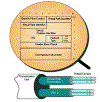| |
ATM VC/VP Concept
The VP (virtual path) concept enables
a bundle of VC’s (virtual circuits) to be handled as a whole by
intermediate nodes, thus avoiding per VC processing operations. For
example, two end systems connected by means of a VP can control the
share of the bandwidth available on the VP to many VC’s in a
transparent manner with respect to the intermediate switches. The
VPI/VCI labels in the ATM cell header have only local significance,
that is, the VPI/VCI pair of a cell changes link by link. ATM
switches implement only the physical and the ATM layers at the user
plane, thus carrying out a set of simple operations on cell streams
belonging to active connections. Physical- and ATM-layer operations,
such as VCI/VPI label swapping and cell routing from input to the
requested output port, are carried out in hardware, thus minimizing
the cell switch crossing time.

Figure 1:
Fixed-Length Cells, VP and VC
|
|